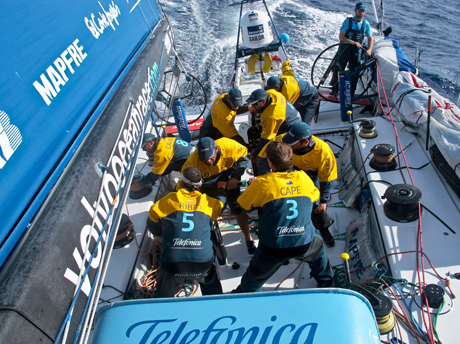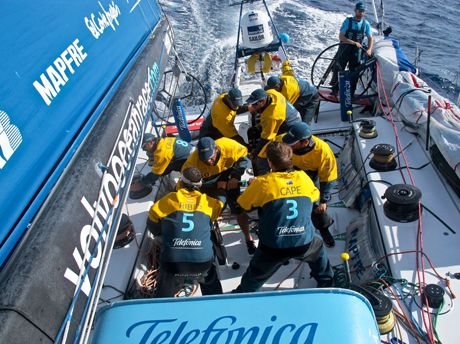
Diego Fructuoso/Team Telefonica/Volvo Ocean Race
I usually don’t get too excited about the tricked-out space ships circling the globe in the Volvo Ocean Race, but when I heard the race fleet was split in half, with three of the Volvo 70s planning to weave through the Solomon Islands, my interest was piqued. While the images of these thoroughbred machines racing down the long swells of the bottom of the planet are impressive, the idea of threading through an area of poorly charted reefs, jungle islands, and notoriously squally weather in the darkness presented a interesting new twist.
The fleet is nearing the end of the 5,200-nautical-mile Leg 4, from Sanya, China, to Auckland, New Zealand, a leg that lacks almost no historical reference points for the racing tactician. In all, the six boats will complete nine legs in their around-the-world bid, with a stop in Miami scheduled for middle of May.
The remote and still poorly charted Solomon Islands offered a trickier-than-usual navigational challenge for the three boats that chose the route through the archipelago, but they seemed to skate through without too much problem. When we were winding through the same islands 16 years ago, the British Admiralty charts we relied on were riddled with errors, causing all sorts of gastro-intestinal problems for the navigator that Ill refrain from detailing here. Weather forecast coverage was spotty at best. Malaria and man-eating crocodiles were lingering worries. The threat of mutiny simmered in the galley.

Darrell Nicholson
The three boats that ducked between the islands of Choiseul and Santa Isabella-Groupama, Team Telefonica, and Team Sanya-skirted right past one of the most fascinating cruising grounds we explored, the Marovo Lagoon, site of many of James Micheners World War II tales and home to some of the most talented wood carvers in the Pacific. I couldnt help but notice how tantalizingly close the boats passed to the Mbili Passage, the gap we sailed through to gain entrance to the lagoon. I tried to imagine the look of shock on the faces of the local fishermen in their dugout canoes when they caught site of one of these alien vessels flying southward toward New Zealand. If one of the village chiefs had caught sight, he no doubt would have tried to collect a levy for using the local waters-a practice that perturbed many cruisers in the Solomon Islands, but one that I didnt find unreasonable, given the circumstances.
Even if you don’t care much for over-the-top sailboats financed by bottomless pockets of their corporate sponsors, the Volvo offers an interesting look at the art of weather routing. The boats have been sailing surprisingly close together for much of the event, and the Race Data page of the Volvo Ocean Race website offers all kinds of cool tools to evaluate forecasts and get an intimate look at the information the pros are using to make their routing decisions. Granted, the average cruiser will never make the time these boats do (500 nautical mile daily runs!), so the passagemaking decisions wont be a good template for cruisers. The site does, however, give the armchair globe-girdler a tangible sense of the many factors at play when making routing decisions-a fun exercise, even if you can’t drop the hook and enjoy some swamp-taro pudding.


































